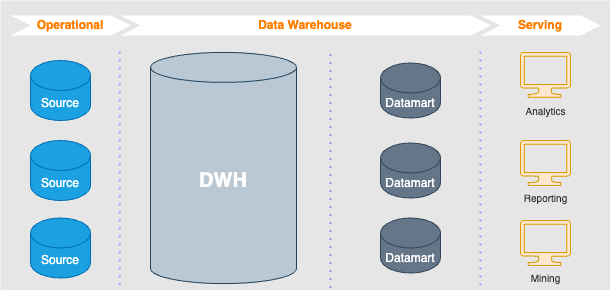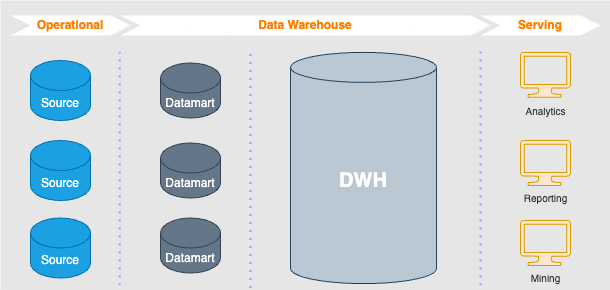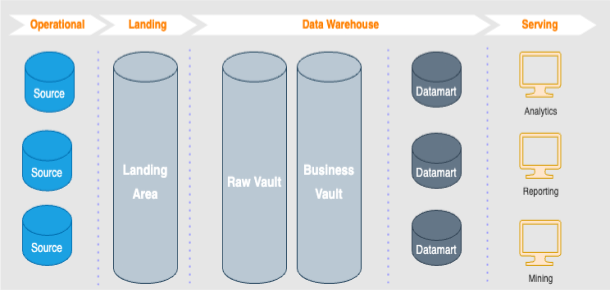
Turn your data into
meaningful & analyzable insights
Seamlessly manage, store and protect your data against all kinds of risks with GTech Data Management Solutions. Keep control of all stages from data backup to recovery.

Scalable data management solutions:
GTech Data Management Services
GTech Data Management Services, which covers all processes such ascollecting , storing, managing and protecting of data, enable you to perform critical operations such as backup and recovery flawlessly while managing your database. In this way, you can access all your data from any point, at any time.
A quick look at GTech Data Management Solutions:
Data Warehouse (DWH) Approach
There are different architectural approaches used to create a data warehouse. Inmon and Kimball approaches are the most used today.In addition, Data Vault is another modeling approach used. Basically, they all aim to store historical data in a data store in a relational manner. None of these approaches is better than the other, and each has its own pros and cons. Which method to proceed with is shaped according to the needs.
-

Inmon
In the middle layer scructure, where all data is collected, the data is kept normalized. Then, separate datamart designs are made for each subject area (e.g., sales, order, collection, etc.) fed from this middle layer. In these datamarts, the data is kept denormalized. Here, with the ”single source of truth" principle, it is aimed to calculate the data once in normalized form and distribute them in denormalized tables.
-

Kimball
A data warehouse is a place where datamarts are prepared as denormalized according to business needs, and then all of these datamarts are collected in the same place.
-

DataVault
In this approach, the data is kept normalized again. It contains tables called Hub, Link, and Satellite, and the data filled into these tables are divided into transactional, dimensional, or relation tables.
GTech experience in DWH implementation
Without a data warehouse, organizations cannot consolidate their data in a single environment and cannot associate their data in different environments with each other. In addition, since applications such as Excel allow data to be changed by users, a reliable environment does not occur.
Thanks to the data warehouse, companies have the opportunity to store their data from different source systems in a single center. Moreover, it is also possible to store all the data with the one true truth principle by associating the data from different sources with each other. Moreover, DWH also stores data changes in certain periods, which
At GTech, we have continued to respond to many different needs in many different sectors since 2000 with our expert staff.
Retention of quality data
Valuable data needs to be analyzed and transformed in order to achieve actionable insights. Managing big data " correctly" helps to efficiently process and validate data and structure information, providing a solid basis for analysis.
Fast processing of big data
Fast processing of big data: With state-of-the-art data management solutions supported by GTech, all data (audio, visual, image, etc.), can be processed in seconds, regardless of their size. With this process, which is independent of the size and type of data, it is possible to make data-oriented decisions.
Modern data management approach
Unlike traditional data management, which requires serious time and effort, GTech Data Management Services eliminate repetitive data while ensuring consistency throughout the entire organization, and information needs are met faster.
Controlled & secure processing
Controlled & secure processing: Data that is not encrypted and access levels are not determined by users can have both reputational and financial consequences. By conducting regular security audits with GTech Data Management Services, you can prevent unauthorized access and data leaks.
Discover our global partners
in data management
The GTech Data Management Services process:
7 major steps
Initialization
We are starting to work to find out if your organization is ready for the data warehouse. It is important to have an organization in place that includes business drivers, an appropriate project sponsor, and the use of data for decisions, and business and IT collaboration.
Analysis
We define your goals together with you in order to design the most appropriate solution for your organization and business processes; we collect available data and evaluate formats in order to achieve the determined goals.
Concept design
We are designing the data warehouse architecture to meet your business needs as a concept. At this stage, we are determining the tables and relations to be created (this process can be done as an ER Diagram, or can also be shown with a Bus Matrix.)
Technical design
This is the section where we physically define all tables and their relations. In this section, we are preparing the project for the next stage by saving the tables that will be the source for the relevant tables and the filling forms of the data.
Development
After storing the data according to the quantity and types using the tips in the previous steps, we fill the data into the tables with ETL/ELT.
Unit tests
We perform consistency checks between existing tables, create inter-layer test scenarios and perform positioning to the data warehouse related to the controls.
Transition to live
After observing how the data management solution we designed performs in the real environment and completing the final preparations, we are taking the project to live.
Industries where data management adds value
- Insurance
- Software
- Health
- Education
- Finance
- Banking
- Marketing
- Advertising
- Logistics
- Retail
- e-Commerce











